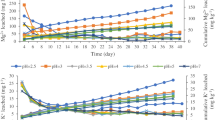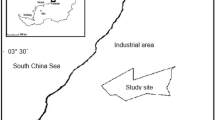Abstract
To clarify the buffering process and karst carbon sink effect of the karst soil with acid rain, experiments on the leaching of sulfuric acid rain were conducted at pH 3.5, 4.5, and 6.5 with different karst soil thicknesses. The buffering process of karst soil on acid rain occurred in the topsoil. During strong acid precipitation, the soil-exchangeable calcium and magnesium were predominantly exchanged with H+ in acid rain, while during weak acid precipitation, the amount of calcium and magnesium exchanged with H+ in acid rain was lower than the H+ generated via dissociation of soil CO2 dissolved in the precipitation. At pH 3.5, 4.5, and 6.5 precipitations, the δ13CDIC value in the leached liquid ranges from − 18.9 to − 14.2‰, − 19.0 to − 13.2‰, and − 12.0 to − 7.1‰, respectively, and with increasing precipitation intensity, the δ13CDIC value was increased, relatively stable, and decreased, respectively. A total of 74% of dissolved inorganic carbon (DIC) in the leached liquid was from soil CO2. In the karst soil area (soil thickness ≥ 10 cm), soil-exchangeable calcium and magnesium can buffer 33,303–336,987 mm in pH 3.5 precipitation and 145,701–371,550 mm in pH 4.5 precipitation, while the soil buffer in pH 3.5 precipitation can generate 0.22–1.04 mol m−2 carbon sink per year, and 0.39–0.64 mol m−2 carbon sink per year in pH 4.5 precipitation.







Similar content being viewed by others
Availability of data and materials
The data that support the findings of this study are available from Institute of Karst Geology, CAGS. Restrictions apply to the availability of these data, which were used under license for this study. Data are available from the authors with the permission of Institute of Karst Geology, CAGS.
References
Amiotte SP, Probst JL, Ludwig W (2003) Worldwide distribution of continental rock lithology: implications for the atmospheric/soil CO2 uptake by continental weathering and alkalinity river transport to the oceans. Glob Biogeochem Cycles 17(2):1038
Batlle BL, Batjes NH, Bindraban PS (2010) Changes in organic carbon stocks upon land use conversion in the Brazilian Cerrado: a review. Agr Ecosyst Environ 137(1–2):47–58
Campeau A, Bishop K, Amvrosiadi N, Billett MF, Garnett MH, Laudon H, Oquist MG, Wallin MB (2019) Current forest carbon fixation fuels stream CO2 emissions. Nat Commun 10(1):1876
Cao JH, Wu X, Huang F, Hu B, Groves C, Yang H, Zhang CL (2018) Global significance of the carbon cycle in the karst dynamic system: evidence from geological and ecological processes. China Geol 1:17–27
Chen HM (2018) Environmental soil science, 3rd edn. Science Press, Beijing (in Chinese)
Cuntz M (2011) Carbon cycle: a dent in carbon’s gold standard. Nature 477:547–548
Dai ZM, Liu XM, Wu JJ, Xu JM (2013) Impacts of simulated acid rain on recalcitrance of two different soils. Environ Sci Pollut Res 20:4216–4224
Dai D, Yu T, Deng YX, Sun FH, Zhao J, He CD (2019) Acid deposition induced base cation loss and different responses of soils and sediments in Taihu Lake watershed, China. Chemosphere 226:149–158
Davidson EA, Janssens IA (2006) Temperature sensitivity of soil carbon decomposition and feedbacks to climate change. Nature 440(7081):165–173
Fang XJ (2020) Effect of acid rain on the structural properties and water movement characteristics of red soil in Hunan. Changsha Univ Sci Technol 24–34
Geng ZC, Jia HT (2020) Soil science, 2nd edn. Science Press, Beijing (in Chinese)
Huang F, Xiao Q, Yin WL, Hu G (2014) The effects of using N-fertilizers in soil on karst carbon sink in karst system. Carsologica Sin 33(4):405–411 (in Chinese)
Huang QB, Qin XQ, Liu PY, Zhang LK, Su CT (2017) Impact of sulfuric and nitric acids on carbonate dissolution, and the associated deficit of CO2 uptake in the upper-middle reaches of the Wujiang River, China. J Contam Hydrol 203:18–27
Huang QB, Qin XQ, Cheng RR, Li TF, Wu HY, Liao HW (2021) Investigation of the hydrogeochemical processes and regional evolution of karst groundwater in Liulin Spring catchment, northern China. Environ Earth Sci 80:20
Jalali M, Moradi A (2020) Measuring and simulating pH buffer capacity of calcareous soils using empirical and mechanistic models. Arch Agron Soil Sci 66(4):559–571
Jalali M, Naderi E (2012) The impact of acid rain on phosphorus leaching from a sandy loam calcareous soil of western Iran. Environ Earth Sci 66:311–317
Jalali M, Peikam EN (2022) Measuring and simulating the effect of acid rain on cations leaching from calcareous soil of Western Iran. Arab J Geosci 15(13):1194
Khadka MB, Martin JB, Jin J (2014) Transport of dissolved carbon and CO2 degassing from a river system in a mixed silicate and carbonate catchment. J Hydrol 513:391–402
Lal R (2004) Soil carbon sequestration impacts on global climate change and food security. Science 304:1623–1627
Lerman A, Wu LL, Mackenzie FT (2007) CO2 and H2SO4 consumption in weathering and material transport to the ocean, and their role in the global carbon balance. Mar Chem 106:326–350
Li SL, Liu CQ, Li J, Lang YC, Ding H, Li LB (2010) Geochemistry of dissolved inorganic carbon and carbonate weathering in a small typical karstic catchment of Southwest China: isotopic and chemical constraints. Chem Geol 277(3–4):301–309
Li L, Li YS, Peng L, Zhou Y, Chai FH, Mo ZY, Chen ZM, Li H (2020) Pollution characteristics and control countermeasures of acid rain in Guilin. Res Environ Sci 33(6):1393–1401 (in Chinese)
Liu CQ, Jiang YK, Tao FX, Lang YC, Li SL (2008) Chemical weathering of carbonate rocks by sulfuric acid and the carbon cycling in Southwest China. Geochimica 37(4):404–414 (in Chinese)
Mcclanahan K, Polk J, Groves C, Osterhoudt L, Grubbs S (2016) Dissolved inorganic carbon sourcing using δ13CDIC from a karst influenced river system. Earth Surf Proc Land 41(3):392–405
Pan YD, Birdsey RA, Fang JY, Houghton R, Kauppi PE, Kurz WA, Phillips OL, Shvidenko A, Lewis SL, Canadell JG, Ciais P, Jackson RB, Pacala SW, Mcguire AD, Piao S, Rautiainen A, Sitch S, Hayes D (2011) A large and persistent carbon sink in the world’s forests. Science 333(6045):988–993
Qin CQ, Li SL, Waldron S, Yue FJ, Wang ZJ, Zhong J, Ding H, Liu CQ (2020) High-frequency monitoring reveals how hydrochemistry and dissolved carbon respond to rainstorms at a karstic critical zone. Southwestern China Sci Total Environ 714:136833
Sheng MY, Xiong KN, Wang LJ, Li XN, Li R, Tian XJ (2018) Response of soil physical and chemical properties to rocky desertification succession in South China Karst. Carbonate Evaporite 33:15–28
Shin WJ, Chung GS, Lee D, Lee KS (2011) Dissolved inorganic carbon export from carbonate and silicate catchments estimated from carbonate chemistry and δ13CDIC. Hydrol Earth Syst Sc 15(8):2551–2560
Wang ZJ, Yin JJ, Pu JB, Xiao Q, Zhang T, Li JH (2021) Flux and influencing factors of CO2 outgassing in a karst spring-fed creek: Implications for carbonate weathering-related carbon sink assessment. J Hydrol 596:125710
Wei XH, Liu SJ, Muller K, Song ZL, Guan GC, Luo JF, Wang HL (2019) Urbanization-induced acid rain causes leaching loss of calcium from limestone-derived soil in South China. J Soil Sediment 19(11):3797–3804
Wei H, Liu YL, Xiang HM, Zhang JE, Li SF, Yang JY (2020) Soil pH responses to simulated acid rain leaching in three agricultural Soils. Sustainability (basel) 12:280
Xie YC, Huang F, Yang H, Yu S (2021) Role of anthropogenic sulfuric and nitric acids in carbonate weathering and associated carbon sink budget in a karst catchment (Guohua), southwestern China. J Hydrol 599:126287
Yang H, Zhou L, Huang LY, Cao JH, Groves C (2015) A comparative study of soil carbon transfer between forest soils in subtropical karst and clasolite areas and the karst carbon sink effect in Guilin, Guangxi, China. Environ Earth Sci 74:921–928
Yu S, He SY, Sun PA, Pu JB, Huang J, Luo HX, Li YS, Li R, Yuan YQ (2016) Impacts of anthropogenic activities on weathering and carbon fluxes: a case study in the Xijiang River basin, southwest China. Environ Earth Sci 75:589
Zhang J, Quay PD, Wilbur DO (1995) Carbon isotope fractionation during gas-water exchange and dissolution of CO2. Geochim Cosmochim Ac 59(1):107–114
Zhang S, Lu XX, Sun HG, Han JT, Higgitt DL (2009) Major ion chemistry and dissolved inorganic carbon cycling in a human-disturbed mountainous river (the Luodingjiang River) of the Zhujiang (Pearl River), China. Sci Total Environ 407:2796–2807
Zhang T, Li JH, Pu JB, Martin JB, Khadka MB, Wu FH, Li L, Jiang F, Huang SY, Yuan DX (2017) River sequesters atmospheric carbon and limits the CO2 degassing in karst area, southwest China. Sci Total Environ 609:92–101
Zhang M, Yang W, Yang MX, Yan J (2022) Guizhou karst carbon sink and sustainability-an overview. Sustainability (basel) 14:11518
Zhao GS, Huang QB, Zhu YN, Li TF, Pu ZG (2022) Simulation of buffering process and carbon sink effect of lime soil on sulfuric acid rain. Carsologica Sin 41(5):796–807 (in Chinese)
Zhou G, Huang J, Tao X, Luo Q, Zhang R, Liu Z (2015) Overview of 30 years of research on solubility trapping in Chinese karst. Earth-Sci Rev 146:183–194
Zhu HY, Wu LJ, Xin CL, Yu S, Guo YS, Wang JL (2019) Impact of anthropogenic sulfate deposition via precipitation on carbonate weathering in a typical industrial city in a karst basin of southwest China: a case study in Liuzhou. Appl Geochem 110:104417
Acknowledgements
The authors would like to thank Prof. Huang Qibo for his valuable comments and suggestions.
Funding
This work was supported by the Key Projects of the Guangxi Natural Science Foundation and the China Geological Survey Project (Grant Numbers 2018GXNSFDA281036 and DD20221758). Author Yiling Xu has received research support from Guilin Water Supply Company Limited.
Author information
Authors and Affiliations
Contributions
All authors contributed to the study conception and design. Material preparation was performed by YX and ZP. Data collection and analysis were performed by GZ. The first draft of the manuscript was written by GZ. QH and YZ commented on previous versions of the manuscript. All authors read and approved the final manuscript.
Corresponding author
Ethics declarations
Conflict of interest
The authors have no relevant financial or non-financial interests to disclose.
Additional information
Publisher's Note
Springer Nature remains neutral with regard to jurisdictional claims in published maps and institutional affiliations.
Rights and permissions
Springer Nature or its licensor (e.g. a society or other partner) holds exclusive rights to this article under a publishing agreement with the author(s) or other rightsholder(s); author self-archiving of the accepted manuscript version of this article is solely governed by the terms of such publishing agreement and applicable law.
About this article
Cite this article
Zhao, G., Huang, Q., Zhu, Y. et al. Simulation of the buffering process of karst soil on sulfuric acid rain and the characteristic of δ13CDIC and the carbon sink flux in Guilin City, southwest China. Environ Earth Sci 82, 296 (2023). https://doi.org/10.1007/s12665-023-10948-6
Received:
Accepted:
Published:
DOI: https://doi.org/10.1007/s12665-023-10948-6




